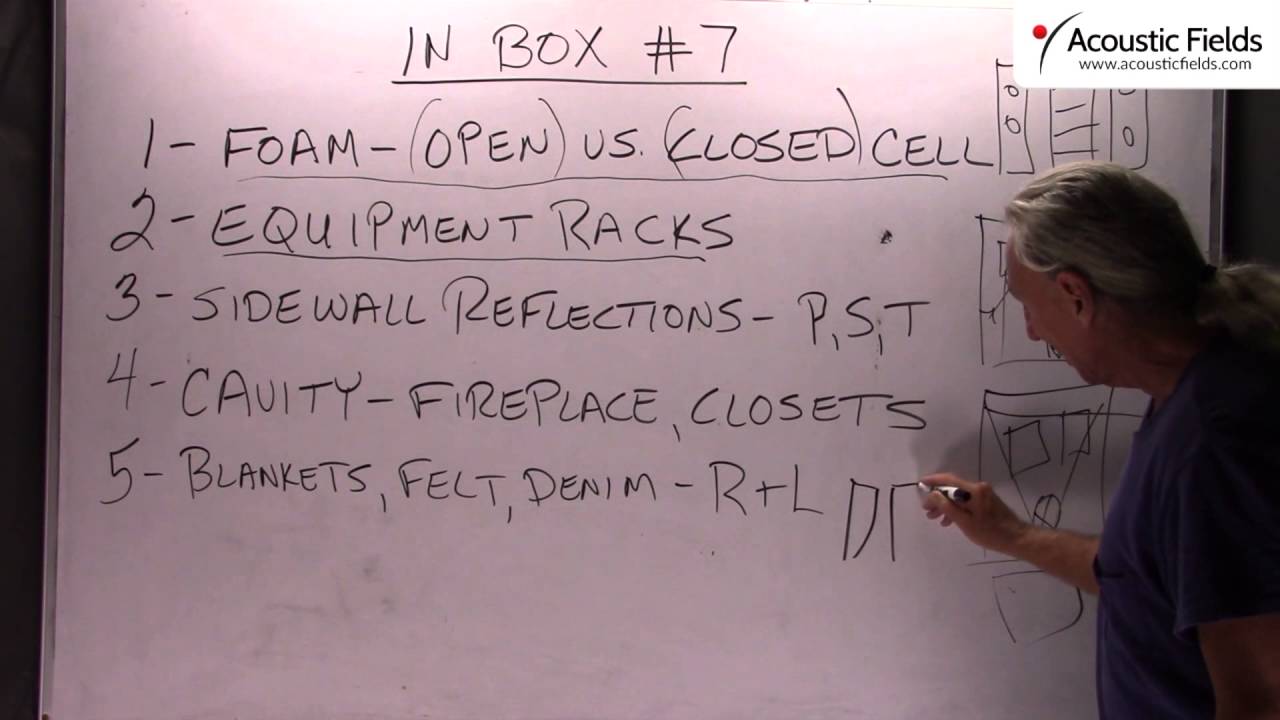Today we’re going to do inbox #7. These are comments and questions that come into my inbox and I see the same ones every time so I thought well, let’s put them up on the board, do a video about them and maybe some of these questions you have can be answered here.
There’s a lot of confusion on foam. People don’t understand the difference between open and closed cell foam. Closed cell foam is the kind of foam that goes in your seat cushions, mattresses, things like that. Open cell foam is the foam we use in the acoustic world and just think about the word open, okay, versus closed.
Open means that it allows for air movement to go through the foam. And you need the air movement because you need the vibration and the friction to create heat which creates absorption. So we need to understand that it’s the open cell foams that we use in acoustical treatment. Closed cell foams, you sit on them, using probably in sports gear and stuff like that, it’s more about impact and compression but open cell is more like molecular velocity and airflow through it.
So those are your two distinctions. So we have to keep those in mind. I get a lot of questions that say, well, I want to use my seat cushion for this, that or the other. So you have to be careful, especially with your higher frequencies, with middle and high.
So you see this a lot in two-channel setups in people’s homes, equipment rack. Remember, this is sacred territory here and I see equipment racks between the speakers and if you look at the elevations of the speakers equipment rack sometimes is as high as the speakers themselves.
So what are you doing here? Well, remember, energy is moving all around in the room, okay? So eventually is going to strike that equipment rack and then it’s going to cause this destructive interference across the direct, wanted energy from the speaker. So you’re creating another reflection point at a very bad position between the two speakers.
So like we say this area is sacred, don’t put anything in this area. This triangle here is a sacred area so no equipment racks, nothing in that area. Now, you can put stuff behind your listening position. That’s okay. But this area from your speakers, back your speakers to listening position, you don’t want anything in there.
If you do do an equipment rack or you do set your equipment between the speakers, keep it low. Don’t get it up here where the mids and the highs are. You’re just going to cause problems. If you don’t believe me, take out your equipment and listen for a while. You’ll hear the difference. Okay?
Sidewall reflections get a lot of issues on this. I think we’ve talked about this on numerous occasions but let’s go through it again because it just won’t go away, it keeps coming back up. So sometimes I see a room that has an open side so they have speakers here. So we have a certain distance from the left channel to the left sidewall and then the right channel there’s no wall, it’s open. Well, you can’t have that. We have to have equal distances that are predictable and consistent because all of these reflections – the primary which is this one, the secondary and then the tertiary which is the third bounce over – all of these are critical to our sound stage formation, our depth, our height. We have to manage these reflections with the right rate and level of absorption or diffusion if that’s our choice.
So we just need to make sure that we have equal boundary surfaces to work with that are consistent and predictable because we want to get this image in the center. So keep your distance the same, no open on one side.
Cavity, you see this a lot: fireplaces, closets, all are resonating chambers. They all produce energy. Whether you hear it or not, it’s there. So you have to realize that those need to be filled. Closets, easy to fill them with clothes. Fireplaces, you have to kind of make something to fit inside the firebox. So keep those technically, you should plug the chimney too but in most hi-fi situations that’s not possible because they are used.
So blankets, felts, denims, cottons. I get a lot of questions on which is the best to use for absorption. Well, I need to know usage, I need to know what you’re doing in the room and more importantly I need to know the rate and the level of absorption on these products. So we can put that calculation into the room and get you the predictability and consistency that you need.
So I’m not against using these products but you’ve got to give me the rate and level to work with. And most of these products don’t have that because they’re not acoustical products, they’re like building insulations. They weren’t designed for that purpose. So remember, rate and level are critical and keeping it the same in every room is critical.
—
This is an unedited transcript from our video series from Acoustic Fields. There will be some errors in grammar and sentence structure that occur during this translation process.
For complete understanding and comprehension, please view the video which is included in this text. For any additional information regarding this topic or others relating to room acoustics, please contact us directly at:
P: 520 – 392 – 9486







